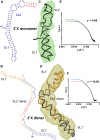Three-dimensional structure of the 3'X-tail of hepatitis C virus RNA in monomeric and dimeric states
- PMID: 28630140
- PMCID: PMC5558915
- DOI: 10.1261/rna.060632.117
Three-dimensional structure of the 3'X-tail of hepatitis C virus RNA in monomeric and dimeric states
Abstract
The 3'X domain is a 98-nt region located at the 3' end of hepatitis C virus genomic RNA that plays essential functions in the viral life cycle. It contains an absolutely conserved, 16-base palindromic sequence that promotes viral RNA dimerization, overlapped with a 7-nt tract implicated in a distal contact with a nearby functional sequence. Using small angle X-ray scattering measurements combined with model building guided by NMR spectroscopy, we have studied the stoichiometry, structure, and flexibility of domain 3'X and two smaller subdomain sequences as a function of ionic strength, and obtained a three-dimensional view of the full-length domain in its monomeric and dimeric states. In the monomeric form, the 3'X domain adopted an elongated conformation containing two SL1' and SL2' double-helical stems stabilized by coaxial stacking. This structure was significantly less flexible than that of isolated subdomain SL2' monomers. At higher ionic strength, the 3'X scattering envelope nearly doubled its size, reflecting the formation of extended homodimers containing an antiparallel SL2' duplex flanked by coaxially stacked SL1' helices. Formation of these dimers could initialize and/or regulate the packaging of viral RNA genomes into virions.
Keywords: 3′X domain; RNA; dimer; hepatitis C virus; small-angle X-ray scattering; structure.
© 2017 Cantero-Camacho et al.; Published by Cold Spring Harbor Laboratory Press for the RNA Society.
Figures





Similar articles
-
Theory Meets Experiment: Metal Ion Effects in HCV Genomic RNA Kissing Complex Formation.Front Mol Biosci. 2017 Dec 22;4:92. doi: 10.3389/fmolb.2017.00092. eCollection 2017. Front Mol Biosci. 2017. PMID: 29312955 Free PMC article. Review.
-
An unexpected RNA distal interaction mode found in an essential region of the hepatitis C virus genome.Nucleic Acids Res. 2018 May 4;46(8):4200-4212. doi: 10.1093/nar/gky074. Nucleic Acids Res. 2018. PMID: 29409065 Free PMC article.
-
Structure and function analysis of the essential 3'X domain of hepatitis C virus.RNA. 2020 Feb;26(2):186-198. doi: 10.1261/rna.073189.119. Epub 2019 Nov 6. RNA. 2020. PMID: 31694875 Free PMC article.
-
The conserved 3'X terminal domain of hepatitis C virus genomic RNA forms a two-stem structure that promotes viral RNA dimerization.Nucleic Acids Res. 2015 Sep 30;43(17):8529-39. doi: 10.1093/nar/gkv786. Epub 2015 Aug 3. Nucleic Acids Res. 2015. PMID: 26240378 Free PMC article.
-
Form confers function: Case of the 3'X region of the hepatitis C virus genome.World J Gastroenterol. 2018 Aug 14;24(30):3374-3383. doi: 10.3748/wjg.v24.i30.3374. World J Gastroenterol. 2018. PMID: 30122877 Free PMC article. Review.
Cited by
-
Theory Meets Experiment: Metal Ion Effects in HCV Genomic RNA Kissing Complex Formation.Front Mol Biosci. 2017 Dec 22;4:92. doi: 10.3389/fmolb.2017.00092. eCollection 2017. Front Mol Biosci. 2017. PMID: 29312955 Free PMC article. Review.
-
An unexpected RNA distal interaction mode found in an essential region of the hepatitis C virus genome.Nucleic Acids Res. 2018 May 4;46(8):4200-4212. doi: 10.1093/nar/gky074. Nucleic Acids Res. 2018. PMID: 29409065 Free PMC article.
-
Evaluating RNA Structural Flexibility: Viruses Lead the Way.Viruses. 2021 Oct 22;13(11):2130. doi: 10.3390/v13112130. Viruses. 2021. PMID: 34834937 Free PMC article. Review.
-
The Role of the RNA-RNA Interactome in the Hepatitis C Virus Life Cycle.Int J Mol Sci. 2020 Feb 21;21(4):1479. doi: 10.3390/ijms21041479. Int J Mol Sci. 2020. PMID: 32098260 Free PMC article. Review.
-
Structure and function analysis of the essential 3'X domain of hepatitis C virus.RNA. 2020 Feb;26(2):186-198. doi: 10.1261/rna.073189.119. Epub 2019 Nov 6. RNA. 2020. PMID: 31694875 Free PMC article.
References
-
- Bartenschlager R, ed. 2013. Hepatitis C virus: from molecular virology to antiviral therapy. Springer-Verlag, Berlin.
Publication types
MeSH terms
Substances
LinkOut - more resources
Full Text Sources
Other Literature Sources
Research Materials
